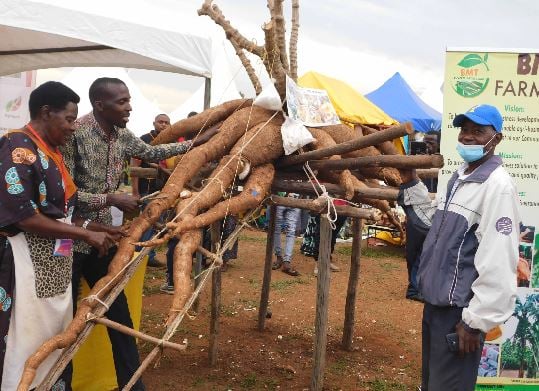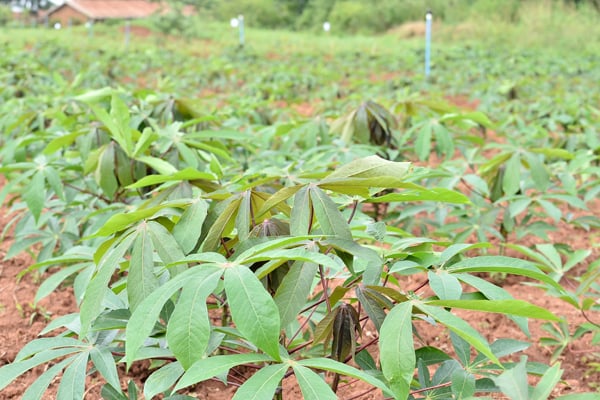Prime
Cassava offers Kato a lot

Speranza Kenyana and son Jude Kato from Isingiro display large cassava tubers to goers at CBS POWESA AGRIBUSINESS FAIR 2022. PHOTO | FILE
What you need to know:
- Jude Kato of BMT farm has increased his farm yields through a farming technique that was popularised by scientists in West Africa after they discovered its effectiveness in the cultivation of yam also known as arrowroot.
A farmer in Isingiro District explores modern multiplication techniques to increase farm produce in cassava planting.
Jude Kato of BMT farm has increased his farm yields through a farming technique that was popularised by scientists in West Africa after they discovered its effectiveness in the cultivation of yam also known as arrowroot.
The minisett technique he explains uses a small part of a non-dormant tuber to be sown and grown until the resulting seed tubers are large enough to be used to grow as food tubers.
He further adds that, “This method is simply implemented through hipping soil continuously to cover the growing nodes on the tubers and eventually creating an artificial anthill.”
The technique was developed on the concept that once the bud sprouts, the roots begin drawing nutrients from the soil and not the mother planting material. Here Kato shares his discovery into a rare cassava variety that greatly improves output on the farm.
The technique
The minisett method that suits the cassava variety is essential to the plant in surviving poor growth conditions.
He lists: “The procedure improves water retention capacity, prevents souring of the harvest, and induces growth which allows the plant to give more under normal circumstances through planting crisscrossing stems.”
The hipping of soil he further explains allows water to easily spend a longer time in the artificial ant hills even during drought hence clearing the plant of a sour taste.
“Usually there is a tendency of cassava as a soft root tuber trying to break the soil and rise on top exposing it to the sun and eventually producing a sour harvest.”
Adding to this, Kato cautions on the excess addition of soil amounts to cover the nodes on the stems.
He shares: “In creating the artificial ant hill, you lose the soil level which results in growth of the stem tubers that create young cassava tubers popping around the hipped soil and expanding the soil hence resulting in a continuous process.”
It is only safe to limit this he tips considering the tubers lying underneath the soil for as long as they are susceptible to spoils.
Planting
According to Kato, the plant variety referred to as TME 14 Cassava is grown with a few stem tubers setup in a crisscrossed format.
He explains: “Ensure that the stem tubers are not planted so deep into the soil to desist germination issues. You can make a hole shallow enough to accommodate it.”
While at it, the expert tips on spacing of three to six stems per plant adding that a recommendable spacing of three meters by three meters approximately 10ft away from each plant from the start of planting is inevitable for the technique.
He says: “Spacing allows for creation of the artificial anthill technique by using the soil from the surrounding to hip onto the cassava.” More conveniently, a spacing of 12ft between plants is recommended for fertile soils.
Pruning
Without pruning, your cassava plant could begin to look rather leggy and straggly. The plant can most likely reach 10ft tall.
However, Kato suggests pruning at 4ft high from the ground; “there is no standard time for the plant to reach 4ft in height. However, this is subject to the amount of rainfall received and soil fertility before the plant is pruned.”
After which, he tips on a period of one month to elapse immediately after each prune to add more soil onto the plant.
Harvesting
When the leaves begin to turn yellow and drop, this is a good sign that the roots are ready to pull up.
According to the expert, the plant is estimated to be ready in about 10-12 months.
“The harvest should not exceed 10months if projected for home consumption to escape the law of diminishing returns on the yields,” he says. Even better, the roots are often boiled or roasted and the leaves, once boiled, are edible too.
Kato recommends processing and commercialisation of the cassava flour after 12months for a rewarding value addition chain hinting on the possibility of product rejection on the market.
He cautions: “After 10 months, it might be a tough sale as a raw product unlike as a processed good because the market refers to it as the rare poisonous type compared to the normal cassava variety.”
The technique
The minisett method that suits the cassava variety is essential to the plant in surviving poor growth conditions.
He lists: “The procedure improves water retention capacity, prevents souring of the harvest, and induces growth which allows the plant to give more under normal circumstances through planting crisscrossing stems.”
The hipping of soil he further explains allows water to easily spend a longer time in the artificial ant hills even during drought hence clearing the plant of a sour taste.
“Usually there is a tendency of cassava as a soft root tuber trying to break the soil and rise on top exposing it to the sun and eventually producing a sour harvest.”
Adding to this, Kato cautions on the excess addition of soil amounts to cover the nodes on the stems.
He shares: “In creating the artificial ant hill, you lose the soil level which results in growth of the stem tubers that create young cassava tubers popping around the hipped soil and expanding the soil hence resulting in a continuous process.”
It is only safe to limit this he tips considering the tubers lying underneath the soil for as long as they are susceptible to spoils.





